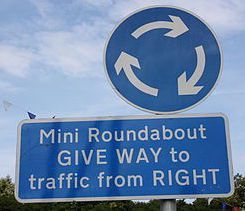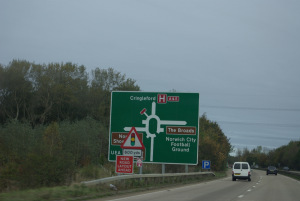Here We Go Around–Roundabouts

Crazy Roundabout in London!
Roundabouts are not something we find often in the U.S. When I lived in New Mexico, we had one in the small town where we lived and no one knew how to drive it (including me). I think more wrecks occurred in that spot than anywhere else in town and there is even a YouTube video of someone crashing into the middle of the roundabout by jumping the foot and a half barrier.
In England, however, Roundabouts are a frequent and common occurrence. It is nearly impossible to drive anywhere without encountering at least one. Large, small, simple, complex–there are lots of different types you can come across. For those who have asked or wondered about the fun of roundabouts, I’m going to try to give the basics. I can’t claim to use the more complex roundabouts and hope to never come across a few I’ve heard of, but I do manage without stopping at the entrance and pausing for 15 minutes (A common complaint about Americans and roundabouts).

Photo courtesy of Ardfern (Wikimedia Commons)
First, you have mini-roundabouts. In the U.S., where we would have a four-way stop, England has a mini-roundabout. This sign is of a sign in Ireland, but the sign here is the same, and the direction below is correct for any roundabout as you do “Give Way to traffic from the right.” For those who don’t remember from my last post, “give way” is the same as yield in the States. When you pull up to this roundabout, you look to the right to see if someone is coming, if not, you can proceed. I do admit that I’m simplifying things a bit. You should signal–not that everyone does, but it does make things flow more smoothly if all involved do so.
That brings us to the next question: How do you use your signal in a roundabout? It isn’t as complicated as one might think if those of us from the U.S. think of it as a four-way stop. Most mini-roundabouts have four roads branching from it, so, in order from when you enter, you either make a left hand turn, go straight, or make a right hand turn.
If going left, you turn on your left indicator when approaching the roundabout, if clear, proceed in and take that first exit. It’s simple.
If you’re going straight, you approach the roundabout with no indicator, enter the roundabout when you can, and at the first exit, turn on your left indicator, proceeding into the exit when you reach it.
Finally, for a right, you approach the roundabout with your right indicator on, enter when you can, and at the exit before you leave the roundabout turn on your left indicator and take your exit.
Always turn on your indicator at the exit before you leave the roundabout! It’s really a common courtesy since a person waiting in the road your taking will know they can enter the roundabout and don’t have to remain waiting for you.
Granted, not all roundabouts are simple. Some have stop lights within the roundabout when they are particularly busy. Some roundabouts have multiple lanes because they have a high amount of traffic and/or have more than four exits. Depends, but the rules remain the same for the indicators, you just have to judge where the exit is, but as long as you turn on your indicator before your exit, you should do well.
If there are multiple lanes in the roundabout, the inside lane is always the last exit(s). Usually, there are arrows on the road to tell you whether you belong in the inside lane or the outside lane before you enter to go straight. When the roundabout itself has more than two lanes, there are often designations painted onto the road to tell you which lane to use.
This page for a driving school here in England has some pretty good illustrations of signalling for those who want a bit more information.
 Larger roundabouts have street signs leading up to the roundabout itself, showing which exits lead to which road or place, to allow you to prepare. They can be a bit confusing. This one not only has more than four exits, but also has stop lights as you can see by the additional sign that blocks part of the roundabout key. I read that in World War 2, they removed these signs in the event the Germans invaded England. I would have been lost! I admit to using GPS/SatNav quite a bit here, but I still rely on the signs! When you are in the roundabout, many also have signs at each exit to help navigate within the obstacle.
Larger roundabouts have street signs leading up to the roundabout itself, showing which exits lead to which road or place, to allow you to prepare. They can be a bit confusing. This one not only has more than four exits, but also has stop lights as you can see by the additional sign that blocks part of the roundabout key. I read that in World War 2, they removed these signs in the event the Germans invaded England. I would have been lost! I admit to using GPS/SatNav quite a bit here, but I still rely on the signs! When you are in the roundabout, many also have signs at each exit to help navigate within the obstacle.
Now, what happens if you miss your exit? Simple, you stick to the inside (if you are in a multi-lane roundabout) and circle around again. If you take the wrong exit, you just have to figure out how to get back. I will say roundabouts work well for U-turns as well :) I’ve taken the wrong exit, and used the next roundabout to U-turn and go back.

Photo courtesy of Wikimedia Commons
For those who are more familiar with this, I know I’ve probably skipped a lot and oversimplified it as well, but it’s the basics. There are some crazy roundabouts out there, and while I’ve driven a double roundabout, I don’t feel qualified to explain most of the multiple, complicated roundabouts out there. Yes, there are multiple roundabouts that blow my mind to be honest. The “Magic Roundabout” in Swindon, which would make me panic, is one example. I think I’d prefer to avoid it if possible!
Like I said, this a pretty simple explanation without getting into any complicated detail. I had no more than this when I set out driving here, and part of getting the hang of it, is trial and error and a few native drivers making dirty hand gestures and swearing at you ;) Honestly, the only way to learn to drive a roundabout is to get in a car and try one!





